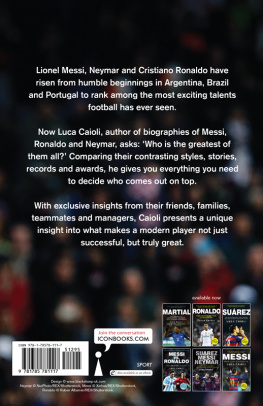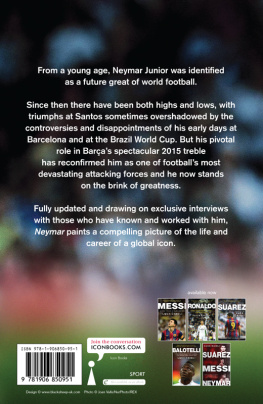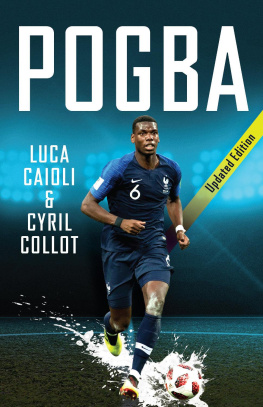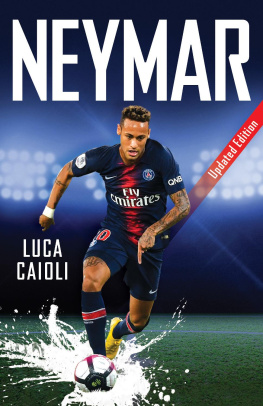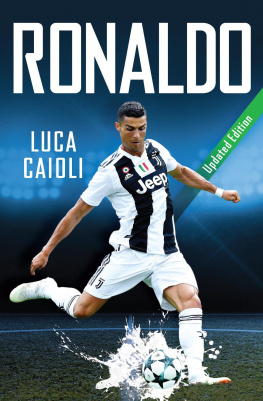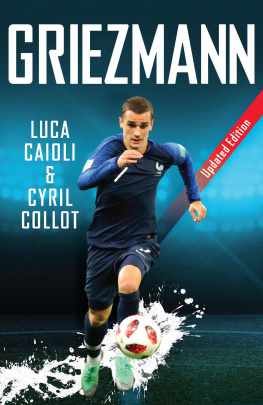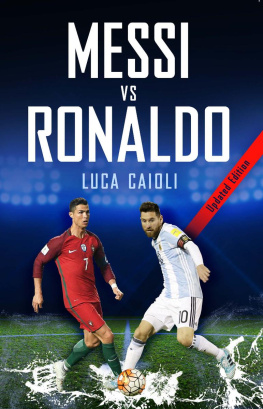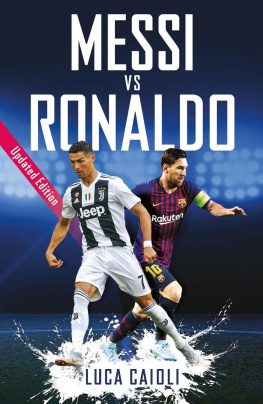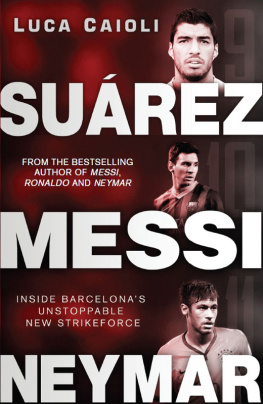MESSI NEYMAR RONALDO
MESSI NEYMAR RONALDO
HEAD TO HEAD WITH THE WORLDS GREATEST PLAYERS
LUCA CAIOLI

Published in the UK and USA in 2016 by
Icon Books Ltd, Omnibus Business Centre,
3941 North Road, London N7 9DP
email:
www.iconbooks.com
Sold in the UK, Europe and Asia
by Faber & Faber Ltd, Bloomsbury House,
7477 Great Russell Street, London WC1B 3DA or their agents
Distributed in the UK, Europe and Asia
by Grantham Book Services,
Trent Road, Grantham NG31 7XQ
Distributed in Australia and New Zealand
by Allen & Unwin Pty Ltd,
PO Box 8500, 83 Alexander Street,
Crows Nest, NSW 2065
Distributed in South Africa
by Jonathan Ball, Office B4, The District,
41 Sir Lowry Road, Woodstock 7925
Distributed in India by Penguin Books India,
7th Floor, Infinity Tower C, DLF Cyber City,
Gurgaon 122002, Haryana
Distributed in Canada by Publishers Group Canada,
76 Stafford Street, Unit 300, Toronto, Ontario M6J 2S1
Distributed in the USA
by Publishers Group West,
1700 Fourth Street, Berkeley, CA 94710
ISBN: 978-178578-111-7
Text copyright 2016 Luca Caioli
Translation copyright 2016 Sheli Rodney
The author has asserted his moral rights.
No part of this book may be reproduced in any form, or by any means, without prior permission in writing from the publisher.
Typeset in New Baskerville by Marie Doherty
Printed and bound in the UK by Clays Ltd, St Ives plc
About the author
Luca Caioli is the bestselling author of Messi, Ronaldo and Torres. A renowned Italian sports journalist, he lives in Spain.
Introduction
Who is the greatest of them all? The best in the world? We are always asking that question. It is part of the culture of football, the collective history of lovers of the beautiful game.
It is a question that has divided and continues to divide experts, fans and entire generations. We relish any opportunity to compare and analyse style, movement, a great play, a free kick, an assist, a goal, a match, a tournament, a World Cup, a Ballon dOr win. We revel in opinion polls in the papers, on news sites and blogs, and pore over results and statistics. We delight in endless debates. Opinion is divided between rival fans, admirers and detractors, different nationalities. And because the collective footballing memory is a fundamental part of the experience, there is always something that evokes another player, another league, another era. This is part of the charm of being just another link in the footballing chain, this constant oscillation between present and past, without which the game would lose something of its fascination.
Who is the best? Pel or Maradona, Di Stfano or Cruyff, Zidane or Platini, Ronaldo Lus Nazrio de Lima or Van Basten? Its a question that has been asked thousands of times, in print, on the radio, on TV. Its a debate that draws in everyone from coaches, players and pundits to the man on the street. Everyone has their own taste, their own opinion, their own idol.
Now the debate centres around Lionel Messi, Cristiano Ronaldo and Neymar da Silva Santos Jnior. Who is the best of the three? Is Messi better than Maradona? Can Cristiano outdo Eusebio? Will Neymar ever overtake Messi, or rise to the heights of fellow countryman O Rei Pel?
While there may not be a definitive answer to be found in these pages, there is plenty of room for opinions and analysis of the three players journeys to stardom, their style and abilities, their achievements both on and off the pitch, their similarities and differences. The idea is simply to present the facts and figures the key to unlocking the stories behind the three best footballers in the world. Then you may draw your own conclusions.
Chapter 1
Childhood
On 23 June 1987 Celia Cuccittini is admitted to the maternity ward at the Garibaldi hospital in Rosario, Argentina. The Messi-Cuccittinis two sons Rodrigo, seven, and Matias, five stay at home with their grandmother, while Jorge Messi accompanies his wife to the hospital. After two boys he would have liked a girl, but the chromosomes dictate that they are to have another boy.
The pregnancy has been uneventful, but during the final few hours complications arise. Gynaecologist Norberto Odetto diagnoses severe foetal distress and decides to induce labour to avoid any lasting effects on the baby. To this day, Jorge can recall the fear of those moments, the panic he felt when the doctor told him that he was going to use forceps, his plea that he do everything possible to avoid using those pincers, which worried him greatly after hearing horror stories about deformity and damage to new babies. In the end the forceps are not needed.
A few minutes before six in the morning on 24 June, Lionel Andrs Messi is born, three kilos in weight and 47 centimetres long, as red as a tomato and with one ear completely folded over due to the force of labour anomalies which, as with many other newborns, disappeared within the first few hours. After the scare comes happiness: the new arrival is a little bit pink, but healthy.
On Tuesday 5 February 1985 at 10.20am in the Cruz de Carvalho Hospital in Funchal, capital of Madeira Island, Portugal, Cristiano Ronaldo dos Santos Aveiro is born. He is 52 centimetres long and weighs four kilos. A fourth child for Mara Dolores dos Santos and Jos Dinis Aveiro, younger brother to Hugo, Elma and Katia. It was an unplanned pregnancy, nine years after the birth of Katia, and now there is the issue of what to name him. My sister, who was working in an orphanage at the time, said that if it was a boy we could name him Cristiano, recalls Dolores. I thought it was a good choice. And my husband and I both liked the name Ronaldo, after Ronald Reagan. My sister chose Cristiano and we chose Ronaldo.
Seven years later on the very same date, 5 February 1992, Neymar da Silva Santos is born at 2.15am in Mogi das Cruzes in So Paulo, Brazil. Nadine Gonalves waters had broken the day before and she had been admitted to Santa Casa de Misericordia, a huge white and blue building nestled between the narrow lanes of the city centre. Its a natural birth, no complications. He weighs 3.8 kilos, and both mother and baby are doing well. Neymars parents didnt know they were having a boy the prenatal scan was too pricey.
At first they are looked after by Doctor Luiz Carlos Bacci no longer alive today and then later discharged by Benito Klei. Klei is a Unio fan, and he knows the baby is the son of a Unio player. But it is only years later, upon seeing the birth certificate again, that he will realise he helped bring a Barcelona superstar into the world.
So, what to call the little guy? The parents havent decided on a name for their firstborn. At first Nadine proposes Mateus, and his father agrees. They test it out for a week, but theyre not convinced. Finally, when Neymar senior goes to register his son, he changes his mind and opts for his own name: Neymar, with the addition of Jnior. The family will all come to call him Juninho.
Lionel Leo Messi, Cristiano Ronaldo and Neymar Jnior are all born into humble families.
Jorge Messi is the head of department at steel manufacturer Acindar, in Villa Constitucin, some 50 kilometres outside Rosario. Mother Celia works in a magnet manufacturing workshop. They own their own home, which Jorge built over many weekends with his father Eusebio on a 300-square-metre plot of family land. Its a two-storey, brick building with a backyard, in Las Heras, a neighbourhood of humble, hardworking people in the southern part of Rosario.
Next page
